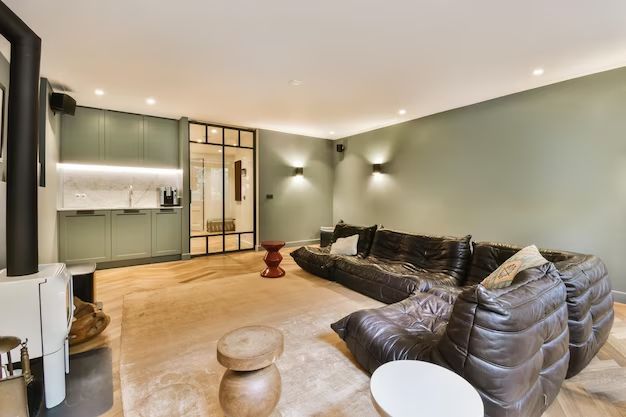When finishing a basement, one of the most exciting parts is choosing the furniture! A basement offers opportunities to create extra living space, like a family room, home theater, game room, home gym, or guest suite. With endless options for decorating a basement, it can be tricky to narrow down what type of furniture is best suited for basement spaces.
Page Contents
Considerations for Basement Furniture
There are a few important factors to keep in mind when furnishing a basement:
- Moisture resistance – Basements tend to be damp, so moisture-resistant fabrics and woods are ideal.
- Durability – Basements can be rough-and-tumble spaces, so durable materials are recommended.
- Weight – Heavy pieces can be difficult to transport down stairs, so lightweight options are often better.
- Scale – Oversized pieces can make basements feel cramped, so sticking to properly scaled furniture is key.
- Layout – Measure the space and create a floor plan before purchasing to ensure everything fits well.
Best Furniture Types for Basements
Here are some of the most suitable furniture options for basement spaces:
Sectionals
Sectionals provide ample, flexible seating for family rooms and home theaters. Look for sectionals with moisture-resistant fabrics or leathers and sturdy hardwood frames. Sectional pieces can be disassembled to get them downstairs.
Recliners
Reclining chairs are ideal for home theaters and reading nooks. Seek out recliners with metal reclining mechanisms and synthetic leather or microfiber upholstery rather than cloth.
Sofas
For furnishing basement living rooms, small-scale sofas are recommended. Loveseats and apartment-sized sofas are easier to maneuver down stairs. Sofas with stain-resistant fabrics and resilient foam cushions are best for basements.
Futons
Futons can provide flexible seating and sleeping space in a basement. Look for lightweight metal futon frames with moisture-resistant cotton or synthetic mattresses.
Armchairs
Upholstered chairs create a cozy seating area in a basement. Choose chairs made with mold- and mildew-resistant fabrics and sturdy hardwood frames.
Benches
Benches are great for additional basement seating or doubling as coffee tables or ottomans. Wood or metal benches with moisture-resistant cushions are ideal.
Coffee Tables
Coffee tables help define a basement living room. Opt for concrete, metal, or wooden coffee tables with damage-resistant finishes.
End Tables
Small end tables provide surface space for table lamps and TV remotes while taking up minimal floor space. Look for metal or wood end tables with water-resistant surfaces.
Media Consoles
Media consoles neatly store electronics and hide cords in a home theater. Seek out metal and engineered wood media consoles able to withstand basement moisture.
Bookshelves
Bookshelves both store items and act as room dividers in open-concept basements. Choose powder-coated metal shelves or reinforced wooden bookshelves that won’t warp from dampness.
Storage Ottomans
Dual-purpose storage ottomans provide extra seating and stash blankets or toys. Upholstered ottomans with waterproof vinyl or polyester fabric are ideal for basements.
Trunks
Vintage-style trunks serve as coffee tables while offering concealed storage. Look for tin, aluminum, or cedar trunks able to withstand moisture.
Desks
Small desks are useful for creating office spaces or homework stations. Select desks made from metal or composite wood materials that resist swelling and warping.
Folding Tables
Lightweight folding tables provide extra table space for game rooms or entertaining. Plastic and aluminum are good folding table materials for damp basements.
TV Stands
TV stands come in many designs appropriate for basement family rooms. Look for stands made of solid wood or steel that include ventilation to prevent electronics from overheating.
Best Furniture Finishes for Basements
Certain furniture finishes are better equipped to withstand basement conditions. Recommended finishes include:
- Powder-coated metals – Resilient against scrapes and scratches while avoiding rust.
- Stained woods – Penetrate surface to seal out moisture.
- Laminates – Durably bonded to furniture surfaces to prevent swelling.
- Plastics – Impervious to moisture while providing protection.
- Synthetic leathers – Made from polymers that won’t crack or peel from dampness.
Fabrics to Avoid in Basements
Some standard upholstery fabrics are prone to mildew and should be avoided, including:
- Cotton
- Wool
- Velvet
- Canvas
- Linen
- Rayon
- Silk
Best basement furniture by room type
The optimal furniture for a basement depends on how the space will be used. Here are recommended furniture types for popular basement rooms:
| Basement Room Type | Recommended Furniture |
|---|---|
| Family room | Sectionals, recliners, small sofas, benches, coffee tables, end tables, desks |
| Home theater | Sectionals, recliners, media consoles, benches, folding tables |
| Game room | Futons, folding tables, trunks, coffee tables, media consoles |
| Home gym | Folding tables, storage ottomans, benches |
| Guest suite | Futons, coffee tables, end tables, desks, benches |
| Teen hangout | Futons, sectionals, benches, folding tables, desks |
Tips for Furnishing a Basement
Keep these tips in mind when selecting and arranging basement furniture:
- Measure staircase and doorways to ensure furniture fits.
- Disassemble items to get them downstairs if possible.
- Let concrete and paint fully cure before placing furniture.
- Use area rugs to define spaces and warm up floors.
- Add built-ins like bookshelves to maximize storage.
- Ensure adequate lighting to show off the space.
- Elevate items off concrete floors to prevent moisture damage.
- Use dehumidifiers and fans to control dampness.
- Sprinkle baking soda on fabrics to absorb musty odors.
- Avoid placing furniture against exterior walls which tend to be cooler.
Conclusion
Furnishing a basement requires selecting durable, moisture-resistant pieces tailored to the room’s purpose. Sectionals, recliners, small sofas, futons, and benches provide flexible seating options. Storage ottomans, coffee tables, end tables, and media consoles add function. Desks, folding tables, and bookshelves are great for maximizing usable space. Pay attention to scale and create a layout that encourages flow between zones. With the right mix of furnishings, a basement can provide expanded living area that your whole family enjoys.
